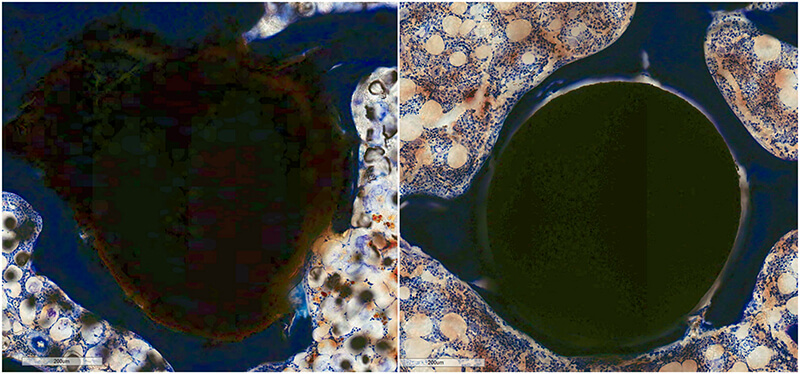April 13, 2017
Nontoxic, biodegradable orthopedic implant could provide superior support to damaged bones, be safely absorbed by the body
 Purdue researchers are developing a biodegradable metal orthopedic implant that could be safely absorbed by the body. The image on the left is a histologic (cell) image of the Purdue-developed metal pins in-vivo in which the metal is being resorbed by the surrounding tissue. The image on the right shows conventional metal pins that are not effectively resorbed by the body. (Image provided by Marine Traverson and Gert Breur/Purdue College of Veterinary Medicine)
Download image
Purdue researchers are developing a biodegradable metal orthopedic implant that could be safely absorbed by the body. The image on the left is a histologic (cell) image of the Purdue-developed metal pins in-vivo in which the metal is being resorbed by the surrounding tissue. The image on the right shows conventional metal pins that are not effectively resorbed by the body. (Image provided by Marine Traverson and Gert Breur/Purdue College of Veterinary Medicine)
Download image
WEST LAFAYETTE, Ind. – Purdue University researchers are developing a nontoxic, biodegradable orthopedic implant that could be safely absorbed by the body after providing adequate support to damaged bones.
The development of the technology originated in the lab of Lia Stanciu, a professor of materials engineering at Purdue in 2009. The technology could eliminate the need for a second surgery to remove conventional hardware.
“Currently, most implants use stainless steel and titanium alloys for strength. This can cause long-term change in the mechanics of the specific region and eventual long-term deterioration,” Stanciu said. “Additionally medical operations that require an orthopedic implant must be followed-up with a second surgery to remove the implant or the accompanying hardware of the implant resulting in higher medical costs and an increased risk of complications.”
Co-inventors of the technology are Stanciu; Eric Nauman, a professor in Purdue’s College of Engineering and director of the College of Engineering Honors Programs; Michael J Heiden, a PhD candidate; and Mahdi Dehestani, a graduate research assistant, both in Purdue’s School of Materials Engineering.
Nauman said the resorbable metal technology provides superior properties compared to conventional metals.
“The implant has high porosity, which is empty space in the material, in which optimal vascular invasion can occur. This provides a way for cells to optimally absorb the material,” he said. “Our technology is able to provide short-term fixation but eliminate the need for long-term hardware such as titanium or stainless steel that may require second surgeries to be retrieved,”
The orthopedic implant also uses manganese, which provides a better degradation rate, Stanciu added.
“Current resorbable metals are made with magnesium; however, this provides many adverse side effects to the body and degrades very quickly,” she said. “We decided to use manganese instead of magnesium. Through studies we found that we can control the degradation rates from 22 millimeters per year to 1.2 millimeters per year pretty consistently. We also saw that manganese has a very good corrosion rate over time.”
Nauman said the technology still exhibits the usual benefits associated with using biomaterials.
“With this technology we are able to tailor the surfaces such as de-alloying the surface to provide a better material for cells to grab on to and grow,” he said. “We were also able to show that we could control cell attachment proliferation, an increase of the number of cells. Our technology still has all these usual benefits in addition to controlling the degradation rates of the metals.”
The Purdue Research Foundation’s Office of Technology Commercialization has patented the technology and it is available for license. For information call 765-588-3470 or email innovation@prf.org.
About Purdue Office of Technology Commercialization
The Purdue Office of Technology Commercialization operates one of the most comprehensive technology transfer programs among leading research universities in the U.S. Services provided by this office support the economic development initiatives of Purdue University and benefit the university's academic activities. The office is managed by the Purdue Research Foundation, which received the 2016 Innovation and Economic Prosperity Universities Award for Innovation from the Association of Public and Land-grant Universities. For more information about funding and investment opportunities in startups based on a Purdue innovation, contact the Purdue Foundry at foundry@prf.org. For more information on licensing a Purdue innovation, contact the Office of Technology Commercialization at innovation@prf.org.
Purdue Research Foundation contact: Hillary Henry, 765-588-3586, hkhenry@prf.org
Sources: Lia Stanciu, 765 496-3552, lastanciu@gmail.com
Eric Nauman, enauman@purdue.edu

